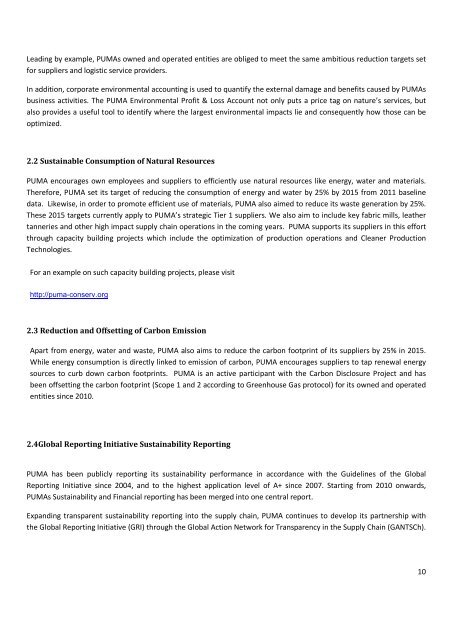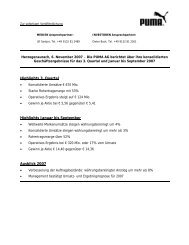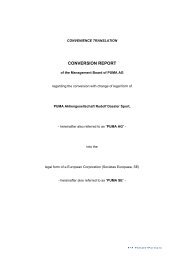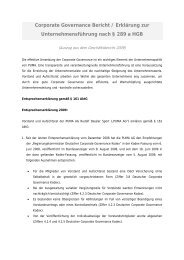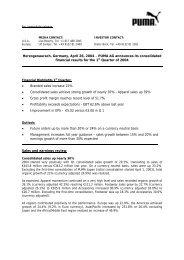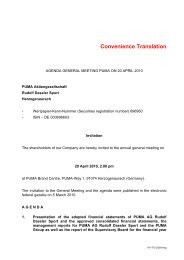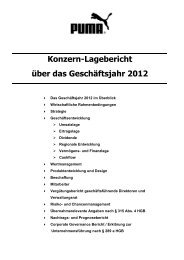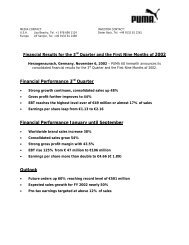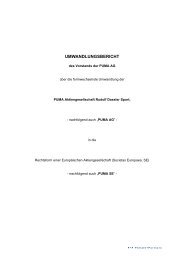PUMA.Safe Environmental Handbook Volume 1 - About PUMA
PUMA.Safe Environmental Handbook Volume 1 - About PUMA
PUMA.Safe Environmental Handbook Volume 1 - About PUMA
Create successful ePaper yourself
Turn your PDF publications into a flip-book with our unique Google optimized e-Paper software.
Leading by example, <strong>PUMA</strong>s owned and operated entities are obliged to meet the same ambitious reduction targets set<br />
for suppliers and logistic service providers.<br />
In addition, corporate environmental accounting is used to quantify the external damage and benefits caused by <strong>PUMA</strong>s<br />
business activities. The <strong>PUMA</strong> <strong>Environmental</strong> Profit & Loss Account not only puts a price tag on nature’s services, but<br />
also provides a useful tool to identify where the largest environmental impacts lie and consequently how those can be<br />
optimized.<br />
2.2 Sustainable Consumption of Natural Resources<br />
<strong>PUMA</strong> encourages own employees and suppliers to efficiently use natural resources like energy, water and materials.<br />
Therefore, <strong>PUMA</strong> set its target of reducing the consumption of energy and water by 25% by 2015 from 2011 baseline<br />
data. Likewise, in order to promote efficient use of materials, <strong>PUMA</strong> also aimed to reduce its waste generation by 25%.<br />
These 2015 targets currently apply to <strong>PUMA</strong>’s strategic Tier 1 suppliers. We also aim to include key fabric mills, leather<br />
tanneries and other high impact supply chain operations in the coming years. <strong>PUMA</strong> supports its suppliers in this effort<br />
through capacity building projects which include the optimization of production operations and Cleaner Production<br />
Technologies.<br />
For an example on such capacity building projects, please visit<br />
http://puma-conserv.org<br />
2.3 Reduction and Offsetting of Carbon Emission<br />
Apart from energy, water and waste, <strong>PUMA</strong> also aims to reduce the carbon footprint of its suppliers by 25% in 2015.<br />
While energy consumption is directly linked to emission of carbon, <strong>PUMA</strong> encourages suppliers to tap renewal energy<br />
sources to curb down carbon footprints. <strong>PUMA</strong> is an active participant with the Carbon Disclosure Project and has<br />
been offsetting the carbon footprint (Scope 1 and 2 according to Greenhouse Gas protocol) for its owned and operated<br />
entities since 2010.<br />
2.4Global Reporting Initiative Sustainability Reporting<br />
<strong>PUMA</strong> has been publicly reporting its sustainability performance in accordance with the Guidelines of the Global<br />
Reporting Initiative since 2004, and to the highest application level of A+ since 2007. Starting from 2010 onwards,<br />
<strong>PUMA</strong>s Sustainability and Financial reporting has been merged into one central report.<br />
Expanding transparent sustainability reporting into the supply chain, <strong>PUMA</strong> continues to develop its partnership with<br />
the Global Reporting Initiative (GRI) through the Global Action Network for Transparency in the Supply Chain (GANTSCh).<br />
10


